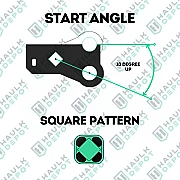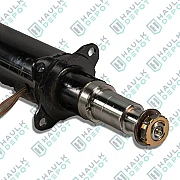Axles & Components






Trailer Axles and Components for Optimal Performance
Selecting the appropriate Axle & Components is the first step in ensuring your trailer operates at its best. Choosing the right axle is crucial for road safety, dependability, and efficiency whether you're moving a boat, utility trailer, travel trailer, or industrial load.
The choice can be bewildering, though, because there are so many different types, capacities, and features of trailer axles available. This manual tends to make things easier. We'll go over the essential details to help you comprehend trailer axles.
Introduction to Trailer Axles
One essential part that sustains the weight of the trailer and its cargo is the axle. It keeps the trailer steady by joining the wheels and enabling rotation. Your trailer will roll easily and safely if you have the proper axle. When purchasing axles and other parts, refer to these definitions:
-
Axle beam: Steel piece connecting wheels; trailer suspension foundation.
-
Lugs: Nuts securing wheels to axle with bolts.
-
Attaching parts: Bolt leaf springs to hangers.
-
Hangers: Mount leaf springs on the trailer.
-
Leaf springs: Curved metal layers supporting trailer weight.
-
Shackles: Let leaf springs adjust on uneven terrain.
-
Equalizers: Link leaf springs; absorb shocks for a smoother ride.
Exploring Different Types of Trailer Axles
Trailer axles come in a variety of forms, each appropriate for a particular use. Torsion axles, drop axles, and leaf spring axles are the most popular varieties. Because of their strength and capacity to support large loads, leaf spring axles are frequently utilized. Because torsion axles employ rubber cords for suspension, they offer a more comfortable ride. Drop axles make loading and unloading a trailer easier by lowering its height.
Single and Tandem Axles
You must choose between single and tandem axles when selecting a trailer axle. Shorter trips and lesser weights are best suited for single axles. They need less upkeep and are simpler to handle. Conversely, tandem axles provide improved weight distribution and stability, which makes them appropriate for larger loads and longer distances.
Check Out Axle Load Capacities
The amount of weight your trailer can support is directly impacted by axle capacity, thus selecting the appropriate axle capacity goods is essential.
One approach to reduce trailer performance is to overload an axle. Trailer axles are available in a variety of capacities to accommodate various requirements. 3.5K, 6K, 7K, 8K, 10K, and even heavy-duty 25K axles are popular choices.
Here are points to help you select the appropriate capacity based on your trailer’s load weight:
-
Small boats or light utility trailers? A 3.5K axle is suitable.
-
Are you moving a medium-sized RV or travel trailer? Choose a 6K-8K axle.
-
Transporting industrial machinery? A 10K to 25K heavy-duty axle is required.
To ensure that you have complete support for your trailer demands, expert guidance can aid you in choosing the proper axle capacity.
Compatibility with Various Trailer Types
The Gross Axle Weight Rating (GAWR), the weight of the trailer, the weight of the load, and the number of axles are some of the variables that affect the trailer axle capacity calculation. The maximum dispersed weight that an axle or axles in an axle group can support is known as the GAWR. Usually indicated on the axle itself, it is decided by the manufacturer.
Step 1: Identify the GAWR.
The trailer's VIN plate has this information, which was supplied by the manufacturer.
Step 2: Calculate the Load Weight.
A scale can be used for this, or if the weight of the load is known, that number can be used directly.
Step 3: Determine the Number of Axles.
To find the weight per axle if your trailer has several axles, divide the total load weight by the number of axles.
Benefits of High-Quality Axles and Components
Although they may not be the most visible component of a trailer, the axles are essential to the system's overall performance and safety. Trailer axles can affect how smoothly your trailer travels down the road if they are built correctly.
Weight Distribution
Distributing the weight of the cargo uniformly across all wheels is one of the main purposes of trailer axles. It is challenging to balance the load when there is no axle support since all of the weight is supported by one place. Wide-ranging concerns including uneven tire wear and handling problems may result from this. Trailer axles are therefore designed to sustain the weight of the trailer and its load equally so that you may drive with stability and control.
Smooth Ride Quality
A trailer's axles, which are connected to its suspension, keep it from bouncing around on the road while it is operating correctly. The cargo and the trailer itself may sustain harm from an uncomfortable and rough ride caused by even the smallest axle system failure. The axles, on the other hand, function flawlessly as the fundamental component of a smooth ride in trailers that are properly maintained.
Toughness and Durability
Because of the many uses for trailers, axles need to be designed with durability and longevity in mind. Potholes, rocks, and other road hazards put steady strain on a trailer. As a result, the axle system needs to be built to endure damage without sacrificing stability or performance. You may be certain that your trailer can manage any task for which it is intended by selecting high-quality trailer axles.
Versatility
There is no one-size-fits-all solution for trailer axles. Depending on the purpose of the trailer, there are various kinds of axles available, each with special characteristics. Sport or utility trailers, which normally have a single axle, can have specialized axles. On the other hand, coupled axles, which offer greater stability and support, are frequently found in freight trailers. To guarantee optimal performance, the axle's type and size must be matched to the trailer.
Maintenance Practices for Longevity
Maintaining the best possible condition for your trailer axle requires routine maintenance. You can guarantee maximum durability and optimal performance by adhering to proper maintenance. Regular maintenance and inspection might identify minor concerns before they become major ones. This straightforward but essential method improves safety and reduces wasteful downtime by preventing trailer accidents.
Inspecting for Wear and Damage
Check the axle frequently for indications of corrosion, wear, or damage. Examine the axle beam and spindles for cracks, bends, or other abnormalities that could indicate excessive hub and bearing wear.
Lubrication and Greasing
Preventing early wear and lowering friction require proper lubrication. As advised by the manufacturer, oil the bearings and other moving components on a regular basis. To guarantee optimum performance, use high-quality grease made specifically for trailer axles.
Checking Alignment and Balance
For safe functioning, maintaining the right alignment and balance is essential. Check the axle's alignment on a regular basis and make any necessary adjustments. To avoid unequal tire and suspension component wear, make sure the load is distributed evenly.
Your trailer's lifetime, performance, and safety all depend on the Axle & Components you choose. You can guarantee a dependable and comfortable ride by being aware of the various axle kinds, choosing the appropriate parts, and keeping them in good condition. A good axle may make all the difference, whether you're transporting large or light items.





















